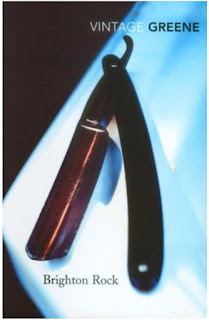Brighton Rock
Graham Greene’s 7th novel, re-released in 2004 as a vintage classic, came into my hands via a book bucket in Katoomba and sat on my shelf for a few years before I got started. I read it in a few days. Compulsive reading. The question is – what’s so appealing to the reader about a ruthless, 17-year old killer? Why has it been adapted into different forms (including a 1944 play, a 1997 radio drama, a failed 2004 musical, and two films – 1947 and 2010)?
I think the answer is, in part, the spectacle of the
slow-motion-train crash. The opening sentence of the novel is a brilliant example
of foretelling: ‘Hale knew, before he had been in Brighton three hours, that
they meant to murder him’ (p.3). He doesn’t make it out of Chapter 1, this journalist. Chapter 2
then introduces ‘the Boy’ (later known as “Pinkie”) whom we soon figure is Hale’s
killer. The story is not a traditional crime story, however -- the primary
crime happens so quickly and we know the murderer. What becomes fascinating is
how Pinkie attempts to cover his tracks, and remove those who might convict
him, and how Hale’s temporary female companion, Ida, acts as a detective-figure
when the official police are even incompetent or bought-off by the mafia. Then
there is Rose – a poor working girl who falls for Pinkie’s abrasive, brash
charms (if there are any) and whose life is soon in danger because of what she knows.
Along the ways, much of what is interesting is to read a
British hardboiled novel – I’d previously swallowed the line that this type of
writing came from the States. Here it is, in 1938. I was reminded of John le
Carré’s The Spy Who Came in from the Cold
– another (later) novel to adopt the American hardboiled style and create a
hybrid spy story. But this novel is much earlier – The Big Sleep, for example, was published in 1939, after Brighton Rock. Of course, Marlowe as
laconic detective is much more central and the corrupt world written on a
bigger scale, but I still say – this is interesting, to read this early British
mafia story. To follow the lives of smaller players; to understand something of
the terrible need to grasp at something beyond the poverty and banal world in
which they exist.
After trying and failing to get something out of “Mr
Colleoni” – a successful Mafia figure – the narrator tells us that ‘the poison
twisted in the Boy’s veins. He had been insulted. He had to show someone he was
– a man’ (p.91). That’s as much motive as Pinkie seems to need – to be a boy
who would be a man, and to live his life as though it mattered – itself a brazen act one thinks for his type (Catholic working
class) in the 1930s. This, I think, is what makes the novel captivating – to follow
the existence of this cruel, egotistical child, more than capable of murder, as
he goes about his own demise and brings down with him anyone who lowers his
opinion of them by showing loyalty.
It might be time for another go at that musical.




Comments
Post a Comment